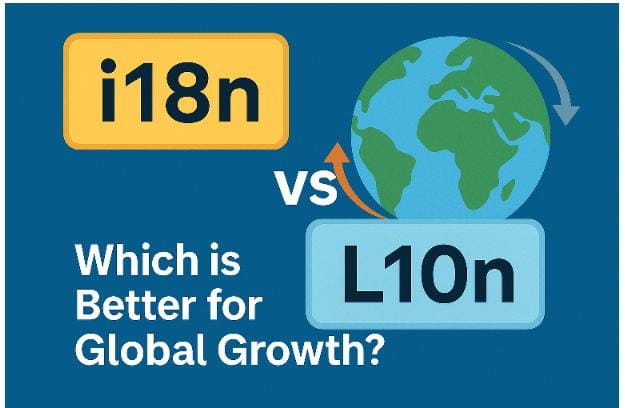
In the fast-paced world of international business, l10n vs i18n is a debate that every company aiming for global growth must understand. Whether you’re launching an app, expanding an e-commerce platform, or building a SaaS solution, success often hinges on how well you adapt your product for diverse markets. While these two processes are closely related, they serve distinct purposes. Knowing when and how to apply each will determine whether your brand resonates worldwide or struggles to connect with international audiences.
What is i18n?
Internationalization (i18n) refers to the process of designing and developing a product in a way that it can be easily adapted to various languages, regions, and cultures without requiring extensive engineering changes. The term “i18n” comes from the fact that there are 18 letters between the "i" and the "n" in the word “internationalization.”
From a technical perspective, i18n is about building the foundations for global readiness. This includes:
-
Language support – Implementing Unicode or UTF-8 encoding so your system can handle multilingual characters.
-
Locale awareness – Designing software to adjust automatically for formats like date, time, numbers, currency, and measurement units.
-
Separation of content from code – Ensuring text strings are stored in resource files rather than hard-coded, allowing translators to work without touching code.
-
Bidirectional text support – Enabling left-to-right (LTR) and right-to-left (RTL) languages.
-
Scalable architecture – Creating a framework that accommodates future languages and regions without structural changes.
In essence, i18n prepares your product for expansion before you even decide which markets to enter. It’s the blueprint for global scalability.
Example: If you build a payment gateway that supports multiple currencies, decimal formats, and character sets from day one, you can easily roll it out in Europe, Asia, or Latin America without rewriting your entire codebase.
What is l10n?
Localization (l10n) is the process of adapting your product or content to meet the language, cultural, and regulatory requirements of a specific target market. The term “l10n” stands for “localization,” with 10 letters between the “l” and the “n.”
While i18n focuses on preparing for adaptation, l10n is about actually doing the adaptation. This includes:
-
Translation – Converting text into the local language with cultural context in mind.
-
Cultural adaptation – Adjusting images, colors, symbols, and examples to fit local sensibilities.
-
Regulatory compliance – Adapting to local laws, such as privacy regulations or product labeling requirements.
-
Market-specific formatting – Tailoring measurements, date/time formats, and currencies to local preferences.
-
SEO and marketing adaptation – Translating keywords and marketing copy so they rank and resonate in local search engines.
Effective l10n goes beyond word-for-word translation. It’s about delivering a user experience that feels “native” to the market, as though the product was created locally from the start.
Example: A food delivery app in Japan might feature local restaurant chains, display yen as the currency, use vertical Japanese text in banners, and show payment options popular in Japan, such as Konbini or PayPay.
Which is Better – i18n vs l10n?
The question of “which is better” isn’t about choosing one over the other, but rather understanding their sequence and interdependence.
-
i18n is the foundation – Without proper internationalization, localization becomes inefficient and costly. If your software isn’t designed for multilingual support, every new market requires significant redevelopment.
-
l10n is the execution – Even with perfect internationalization, your global expansion will fall flat if you don’t localize for each market’s unique needs.
Comparing i18n and l10n for Global GrowthStrategic Insight
-
For startups – Investing in i18n early saves money later. Even if you initially target one market, building with i18n in mind avoids expensive rewrites.
-
For enterprises – Robust l10n ensures that each market entry is culturally aligned, legally compliant, and user-friendly, boosting adoption rates.
In reality, i18n and l10n work best as a continuous cycle. First, design for adaptability (i18n). Then, localize (l10n) for each market, collecting user feedback to inform future updates.
I18n vs L10n: Final Thoughts
When aiming for global growth, thinking in terms of “i18n vs l10n” as an either-or choice is misleading. They are complementary stages of the same international expansion process.
-
Without i18n, your localization efforts will be slow, expensive, and error-prone.
-
Without l10n, your internationalized product will feel generic and disconnected from local audiences.
Best practice:
-
Start with i18n in development – Make your product architecture language- and culture-ready.
-
Apply l10n strategically – Choose target markets based on demand, then localize deeply for each.
-
Measure and refine – Track KPIs such as user retention, conversion rates, and NPS in each localized market to continuously improve.
Businesses that integrate both from the outset achieve faster time-to-market, higher ROI, and stronger brand presence in multiple regions.
FAQs
1. Can you do l10n without i18n?
Yes, but it’s inefficient. Without internationalization, localization often requires reworking core code and structure, making it costly and time-consuming.
2. Is i18n only relevant for software?
No. While i18n originated in software development, its principles apply to websites, digital content, and even physical products that require adaptation for global markets.
3. How much does localization cost compared to internationalization?
Internationalization is typically a one-time infrastructure investment, while localization costs vary per market and per update. Long term, i18n reduces total localization expenses.
4. Should small businesses invest in i18n from the start?
If global expansion is part of your future plans, yes. Early i18n planning saves significant effort when scaling internationally.
5. Which comes first – i18n or l10n?
i18n should always come first. It sets the stage for smooth, efficient localization in multiple markets.
6. How many languages should I localize first?
Start with your highest-potential markets. Analyzing user data, competitor presence, and market demand can help prioritize which languages will yield the greatest ROI.
7. Does i18n improve SEO?
Indirectly, yes. Internationalization supports localization, which is essential for multilingual SEO. By preparing your product for multiple languages and markets, you make it easier to implement region-specific keywords, URLs, and metadata.
8. What’s the role of AI in i18n and l10n?
AI can accelerate both processes by automating translation, detecting formatting issues, and providing cultural adaptation suggestions. However, human review remains crucial for accuracy and cultural relevance.
9. Can I test localization before launching in a market?
Absolutely. Many companies run “soft launches” or beta releases in new regions to gather user feedback before a full rollout.
10. How often should localized content be updated?
Localization is not a one-time task. Update it whenever there are product changes, marketing campaigns, or shifts in local trends and regulations.
Media Contact
Company Name: Crowdin
Contact Person: Robert Miller
Email: Send Email
City: New York
Country: United States
Website: https://crowdin.com/







